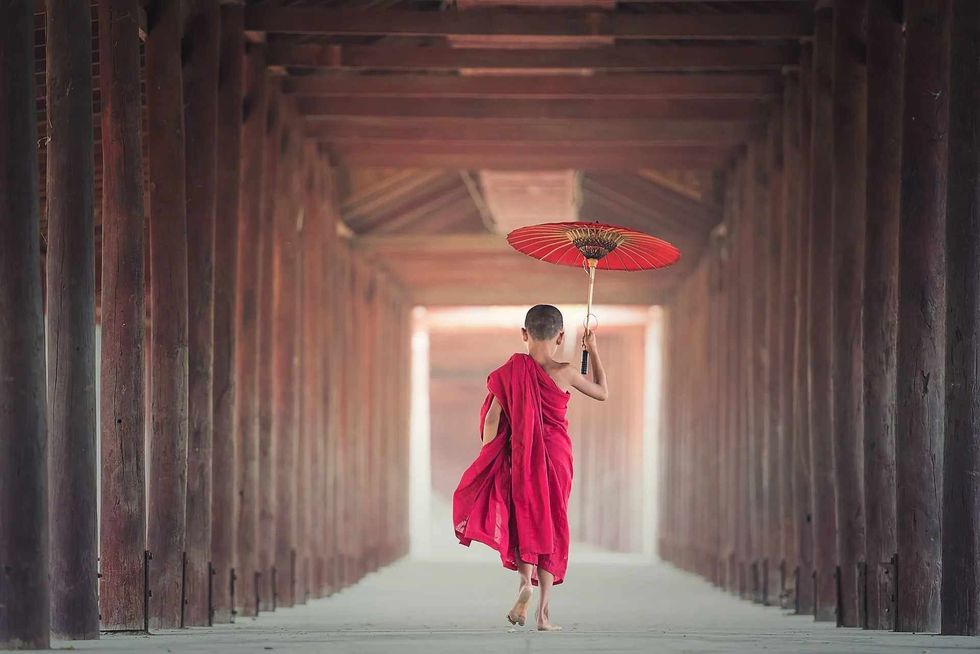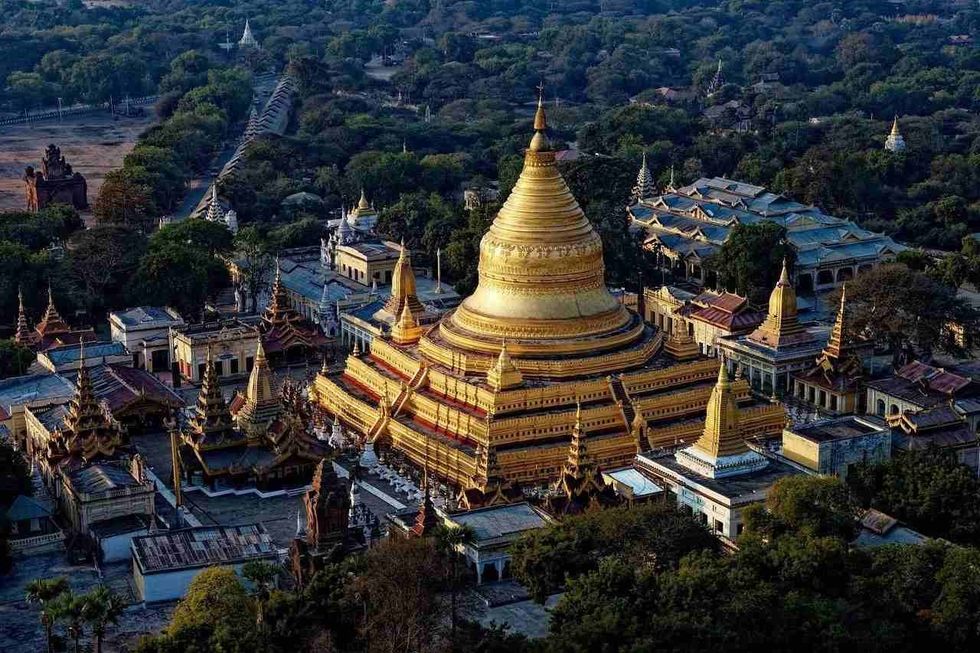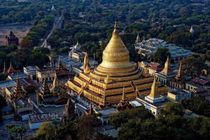77+ Myanmar Facts To Satisfy The Geographical Bug In You

Myanmar is also known as Burma or Mranma Pran in the Burmese language.
Myanmar is located in the western part of mainland Southeast Asia, which also happens to be the largest country in mainland Southeast Asia. Myanmar has a population of about 54 million citizens.
The capital of the country is Nay Pyi Taw, which was declared in 2006. Five main physiographic regions can be found across the expanse of the nation.
These include the mountainous region in the north, western ranges, plateau towards the east, central lowlands and basin, and the coastal plains. A multitude of ethnic diversity can be found in Myanmar, the majority of the population being Burmans, who account for almost half of the country’s population.
Other ethnic groups which can be found are Karen, which occupy the hilly regions and plains of Myanmar. They are the second largest group in terms of population.
The number of minority ethnic groups includes Shan and other groups which inhabit the upland regions of Myanmar, together forming about one-fifth of the nation’s population. The official language of Myanmar is Burmese, although you can find several indigenous languages and various dialects spoken all across the country.
The weather in Myanmar mainly revolves around three different seasons, cool, dry monsoon from late October to mid-February, hot and dry inter-monsoon from mid-February to mid-May, and monsoon from mid-May to late October.
With the majority of the population in Myanmar being rural and agrarian, subsidiary professions like forestry, fishing, and rice farming are the largest contributors to the country’s economy.
Almost half of the agricultural land is involved in rice farming in Myanmar. The age index of Myanmar is quite youthful, with more than one-quarter of the population being under the age of 15 years. Interesting to discover Myanmar genocide facts or Myanmar history facts? Keep reading. We've got plenty of interesting facts about Myanmar and the military government.
The History Of Myanmar
Myanmar has been known for being a significant trade route between western Asia and southeast Asia for thousands of years. During the first century CE, the major land trade route between India and China passed through Myanmar, which is why it's also called the gateway for western countries of Southeast Asia.
Because of the ongoing trade, many Indian wealthy merchants inhabited certain parts of Myanmar, bringing with them political and religious ideas and Indian culture and traditions. These had quite an influence on the Indigenous Burmese culture, shaping their society, arts, crafts, and thoughts.
Myanmar is also considered to be one of the first regions in Asia to receive Buddhism, making it the center of Theravada Buddhist practice by the 11th century.
The dawn of the 11th century saw the rise of the kingdom called Pagan, which had their kingdom spreading across what is present-day Myanmar.
The Pagan dynasty is also said to be the longest surviving dynasty in Myanmar, which ruled over the region for about two centuries. By the end of the 13th century, Mongols from central Asia usurped the power and Pagan was no longer the central power in Myanmar.
For many years after that, the political situation and the kingdom remained fragmented, with minor battles often breaking out between the borders.
One dynasty named Ava rose to power by 1364 and became the most powerful kingdom of the time. This kingdom resurrected the traditions of the Pagan dynasty.
The period of Ava rule in Myanmar is also seen as the biggest artistic and literary revolution of Burmese literature and arts.
The kingdom of the Ava dynasty saw a brief decline in power in 1527 when it was sacked by Shan. The second Ava dynasty was resurrected by the end of the 16th century, although it lacked the political influence it held a century before, making their rise to power brief.
During the same time, new commercial activities had sprung up in the southern parts of Myanmar because of the growth of trade and trade movement by the Dutch and the British. A dynasty named Bago had grown stronger in the south during this time, as Ava was trying to regain its power in northern Myanmar.
Soon enough, in around 1752, Bago rebelled against other weaker dynasties ruling in the regions of Myanmar, leading to the fall of the long-standing Ava dynasty and a smaller Toungoo dynasty. But Bago dynasty’s victory was short-lived as a popular Burman leader named Alaungpaya soon drove out Bago’s forces from northern Myanmar.
Later, Alaungpaya’s son conquered the regions of Rakhine and occupied the princely state of Assam, which was then under British control in India. This led to the first-ever Anglo-Burmese war from 1824-1826, resulting in Myanmar surrendering and relinquishing the regions of Assam, Manipur, Rakhine, and Tenasserim to the British colonies.
The second Anglo-Burmese war took place in 1852 when the British were trying to get access to the teak forests in and around the regions ruled by the Bago dynasty in the south. The British colonizers also wished to secure a trade route passing through Myanmar.
The war resulted in the British annexing the Bago province to their colonies, renaming it later as lower Burma.
The third Anglo-Burmese war took place when Britain declared war on Myanmar in 1885. By the end of November 1885, the British took over Mandalay, which was the capital of the northern province of Myanmar.
Although the troops surrendered easily, many armed conflicts between the regional forces and British forces continued for several years. Soon, an order of colonization of the region of northern Myanmar and the annexation of upper and lower Burma with Indian colonies was declared in 1886.
Rangoon, which is now known as Yangon, became the capital of the British province of Lower Burma. This declaration also saw the end of monarchy and exile for the then ruling King Thibaw, as well as the separation of the government from religious affairs.
This resulted in the Buddhist monks losing their traditional status and patronage, which they earlier enjoyed in the Buddhist kingdom.
The British government also eliminated the office of the patriarch of the Buddhist clergy, which enjoyed a lot of rights and power in the religion-based monarchy. These two pillars, which formed the society of Myanmar monarchy and religious monkhood, suddenly vanishing from the governance and was one of the most devastating consequences faced by the people of Myanmar.
By the '20s, the British government had taken a firm hold in the regions of Myanmar. With many people rebelling against the government, some constitutional reforms were granted in 1923, although several political leaders, as well as the masses, were starting to doubt whether peaceful protests would help them attain their rightful freedom.
A radical group of students at the University of Rangoon started to organize protests against British oppression, which is today known as the Thakin movement.
In 1930, the Burmese peasants rose in rebellion under the leadership of Saya San, by attacking the Indian and British troops stationed in their areas and chasing them away, with the help of only swords and sticks.
In 1936, members of the Thakin movement rose again in rebellion under the leadership of Thakin Nu of U Nu and Aung San.
In 1937, Burma was separated from India and became an independent country with its independent constitution, under British rule.
An arrest warrant was issued after this for Aung San, although he had escaped to China by that time. There, Aung San sought support from the Japanese government for overthrowing British rule in Myanmar. Aung San recruited 29 men and trained them in combat and military to form the Thirty Comrades team.
The Japanese troops were led by Aung San and his team, which soon announced themselves as the Burma Independence Army, and by 1942 they occupied the country. The Japanese took hold of the freshly occupied country of Myanmar and appointed Ba Maw as the first prime minister.
Although Myanmar became free, it was still being ruled by the Japanese troops, and when they started to face opposition, the Japanese declared Burma as a sovereign state and retreated their troops.
Aung San later joined the British side under the influence of Lord Mountbatten and offered the cooperation of the Burma National Army. This resulted in the British military returning to Myanmar and demanding that Aung San be declared as a traitor for driving out and rebelling against British military forces.
But Lord Mountbatten knew Aung San’s influence on his troops and sent Sir Hurbert Rance to head the administration.
Sir Rance then formed a new cabinet, which included Aung San, and soon discussions about the peaceful transfer of power to the Burmese government commenced. In January 1947, the British government agreed to Burma’s independence, and within a few months, Burma was no longer a part of the British Commonwealth of Nations.
In July 1947, Aung San and the members of his cabinet were assassinated by gunmen hired by one of the members of the opposition conservative party who was also a former prime minister, U Saw. Rance then asked Thakin Nu to form a new cabinet.
On Jan 4, 1948, Burma became a sovereign, independent republic after a new constitution came into force.
In 1974, Prime Minister Ne Win instituted a new constitution, which nationalized some of Burma’s major enterprises. Because of this, the economic situation in Myanmar deteriorated quickly, giving rise to a black-market economy.
This situation of economic upheaval continued for several years, resulting in years of rampant corruption, sudden and frequent changes in economic policies, and shortage of basic resources like food and grains. Several people, including school students, could be seen protesting around the country from time to time.
In August 1988, the army opened fire on a giant group of protestors, resulting in the loss of almost 3000 lives. Ne Win resigned after this incident as the chairman of his party.
Soon, military junto took hold of power in the country and the Union of Burma was changed to become the Union of Myanmar in 1989.
It was argued that the name Burma results from British colonization, which favored the Burmese ethnic majority, while Myanmar is a more inclusive term which takes into consideration the ethnic diversity of the country. The capital, Rangoon, was also renamed Yangon for the same reason.
The administrative capital of Myanmar was moved from Yangon to Nay Pyi Taw in 2005 by the military government. For most of the years that Myanmar has been an independent country, it has seen ethnic and religious wars, which are also known for being one of the world’s longest-running and still ongoing civil wars.
Several worldwide organizations like the United Nations have consistently pointed the lack of human rights and the volume of human rights violations that take place in the country.
In 2020, Aung San Suu Kyi recently won the Myanmar general elections by a majority vote, but recently, the Burmese military seized power again from the democratic party in a coup d’état. Currently, Prime Minister Aung San Suu Kyi is under house arrest under various ‘politically motivated’ charges like corruption and violation of covid protocols.
The country is facing widespread protests from the civilians, which the military junta is handling with violent and oppressive means.
Tourist Attractions Of Myanmar
The number of tourists visiting Myanmar is quite low, even lower than its neighboring country of Laos. This is mainly because of the constantly changing political situation of the country.
However, a brief rise in tourism was seen when the military junta had transferred its power to the civilian government. In 2012, the number of tourist arrivals in Myanmar surpassed one million tourists for the first time ever.
The destinations which attract many tourists include cities like Yangon and Mandalay, nature parks and natural reserves like Inle Lake, Kengtung, Putao and Kalaw. There are two destinations in Myanmar that have been declared as World Heritage Sites by UNESCO.
One of them is Pyu City-States, which includes the city-states of Halin, Beikthano and Sri Ksetra. Another heritage site is the ancient city of Bagan, located in Mandalay. This site includes all the monuments which were built in the ancient capital of the Pagan kingdom.
Another popular tourist destination is Inle Lake, which is a mountain lake and a preserved cultural landscape near central Myanmar. Hkakabo Razi landscape includes Hkakabo Razi National Park and Hponkan Razi Wildlife Sanctuary if you wish to explore the wilderness of Myanmar.
The Taninthayi forest corridor is a mixed deciduous forest and is the native place of an endangered species of bird called Gurney’s pitta.

The Neighboring Countries Of Myanmar
Looking for some interesting facts about Myanmar? Read on for some Myanmar country facts about the neighboring countries of Myanmar which will compel you to pick up the Myanmar map right away. The country of Myanmar is surrounded by the following nations:
China- Towards north and northeast
Laos- Towards the east
Thailand- Towards the southeast
Bangladesh- Towards the west
India- Towards the northwest
The country of Myanmar lies along the Indian and Eurasian plates, towards the southeast of the Himalayas. The Andaman Sea lies towards the southern part of the country, while the Bay of Bengal towards the southwest.
What currency do they use in Myanmar?
Here are some interesting facts about Myanmar currency:
The currency of Myanmar is the Kyat. Kyat is abbreviated as K or Ks depending on the number and is generally placed before or after the numerical value.
One Kyat is divided into 100 pyas, although the pya is a very small amount of money and is hardly ever used today. The term Kyat was derived from the ancient Burmese unit of Kyattha, which equaled about 0.57 oz (16.1 g) of silver.
We Want Your Photos!
More for You
Bachelor of Commerce, Master of Business Administration specializing in Marketing

Supriya JainBachelor of Commerce, Master of Business Administration specializing in Marketing
As a skilled member of the Kidadl team, Shruti brings extensive experience and expertise in professional content writing. With a Bachelor's degree in Commerce from Punjab University and an MBA in Business Administration from IMT Nagpur, Shruti has worked in diverse roles such as sales intern, content writer, executive trainee, and business development consultant. Her exceptional writing skills cover a wide range of areas, including SOP, SEO, B2B/B2C, and academic content.
Postgraduate Diploma in Management

Sakshi RaturiPostgraduate Diploma in Management
Sakshi has experience in marketing strategy, social media planning, and recruiting industry experts for capstone projects, she has displayed a commitment to enhancing their skills and knowledge. She has won multiple awards, including a Certificate of Appreciation for Creative Writing and a Certificate of Merit for Immaculate Turut, and is always seeking new opportunities to grow and develop.
Disclaimer
1) Kidadl is independent and to make our service free to you the reader we are supported by advertising. We hope you love our recommendations for products and services! What we suggest is selected independently by the Kidadl team. If you purchase using the Buy Now button we may earn a small commission. This does not influence our choices. Prices are correct and items are available at the time the article was published but we cannot guarantee that on the time of reading. Please note that Kidadl is a participant in the Amazon Services LLC Associates Program, an affiliate advertising program designed to provide a means for sites to earn advertising fees by advertising and linking to Amazon. We also link to other websites, but are not responsible for their content.
2) At Kidadl, we strive to recommend the very best activities and events. We will always aim to give you accurate information at the date of publication - however, information does change, so it’s important you do your own research, double-check and make the decision that is right for your family. We recognise that not all activities and ideas are appropriate for all children and families or in all circumstances. Our recommended activities are based on age but these are a guide. We recommend that these ideas are used as inspiration, that ideas are undertaken with appropriate adult supervision, and that each adult uses their own discretion and knowledge of their children to consider the safety and suitability. Kidadl cannot accept liability for the execution of these ideas, and parental supervision is advised at all times, as safety is paramount. Anyone using the information provided by Kidadl does so at their own risk and we can not accept liability if things go wrong.
3) Because we are an educational resource, we have quotes and facts about a range of historical and modern figures. We do not endorse the actions of or rhetoric of all the people included in these collections, but we think they are important for growing minds to learn about under the guidance of parents or guardians.







